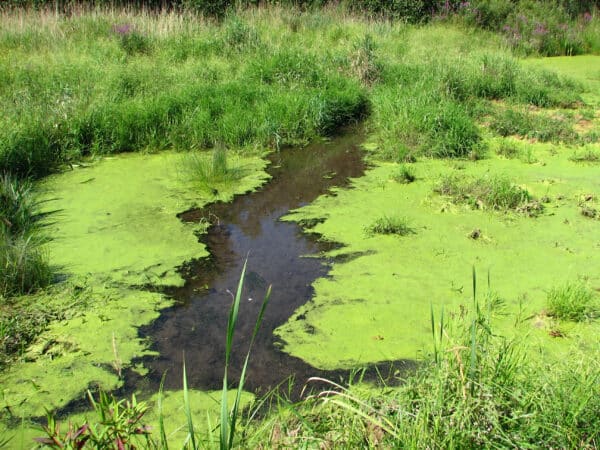You may have heard horror stories of dogs dying after swimming in or drinking from a pond with an alga cover. This is a true danger that can be avoided. The term blue-green algae is a misnomer, as this organism is, in fact, a single-celled organism called cyanobacteria.
This toxic organism can live in a variety of water types and uses photosynthesis to make food. Cyanobacteria can affect humans, wildlife, pets and livestock, however, dogs appear to be more sensitive to the cyanobacteria toxins.
Where can my dog encounter toxic algae?
Cyanobacteria can live in freshwater, saltwater or a combination of both fresh and saltwater. These toxic blooms can be found in lakes, ponds, oceans, puddles and water troughs. There is no minimum depth of water necessary for cyanobacteria to bloom.
What does a toxic cyanobacteria bloom look like?
Not all cyanobacteria strains are toxic. Thousands of types of cyanobacteria exist, but only about 80 species produce harmful toxins. Unfortunately, there is no way to differentiate between toxic strains and nontoxic blooms just by looking at their appearance with the naked eye. Toxic and nontoxic blooms often mix together.
Although the term blue-green algae suggests that cyanobacteria take on a blue or green color, cyanobacteria can have almost any color ranging from green, brown, red, pink and blue. Many bodies of water affected by this toxic organism have a pea-green color.
What conditions create blue-green algae?
The following conditions promote the growth of cyanobacteria:
- Stagnant water in warm weather. These toxic blooms often occur during summer months.
- Lack of rain. This causes more water stagnation and can promote toxic strains of cyanobacteria.
- Water that has agricultural runoff. This provides excessive nutrients that shift the environment to promote toxic blooms. This may explain the prevalence of cyanobacteria in the Midwest, because more bodies of water are adjacent to farmland.
- When in doubt, avoid bodies of water that are opaque or discolored.
What happens if my dog swims or drinks water with toxic cyanobacteria present?

Cyanobacteria can occur in pockets and may be more concentrated at the shoreline. Depending on the type of organism and the type of contact, your dog may experience the following:
- Itching or hives on the skin
- Diarrhea
- Drooling
- Uncontrolled urination
- Seizures/tremors
- Rigidity
- Sedation
- Excessive tear production
- Blue gums/tongue
- Trouble breathing
- Fast or slow heartbeat
- Death
Treatment for algae poisoning in dogs
Unfortunately, exposure to even a small amount of cyanobacteria can be fatal even with treatment. Most dogs succumb to their symptoms within 20 minutes to and up to one or two hours after exposure. Some dogs that receive immediate medical care after a very minor exposure may recover.
Dogs that receive medical attention require anticonvulsant medications to treat seizures. A muscle relaxant may be used to control muscle tremors. Atropine may be used to keep the heart from slowing too much. Pain and anti-nausea medications may also be used to treat pain and nausea. Veterinarians often also employ warming therapies to help treat a low body temperature.
How can blue-green algae be so toxic to dogs?
The toxic strains of blue-green algae contain neurotoxins or hepatotoxins. This means they are toxic to the nervous system or the liver. Some strains can also be toxic to the skin. The neurotoxin stimulates the nervous system and then creates a block that causes respirations to cease. This ultimately results in death.
Is there a way to distinguish regular pond scum from toxic blue-green algae?
There is no definitive way to distinguish between them without a microscope. However, regular pond scum is filamentous while cyanobacteria is not. This means that common pond scum will drape over a stick that is run through the water. Cyanobacteria (toxic blue-green algae) will separate in the water and will not drape. Be aware that both types of organisms can be present simultaneously.
When cyanobacteria are killed or begin to die, they emit a rotting egg or rotting food smell that can alert you to their presence. Even after cyanobacteria are dead, their toxins are present in the water and can cause toxicity.
Local government agencies may post warning signs online and/or close to the water source to protect people and animals during times of toxic blooms. If you see a cover of foam or water that looks streaked with paint, out of an abundance of caution, it’s best to avoid swimming, drinking or boating in that body of water.
What to do about blue-green algae and dogs
With the reality of climate change warming the planet, the number of toxic algae blooms will increase in prevalence and severity, causing a rise in injuries and deaths to dogs. Avoiding conditions that favor toxic cyanobacteria is key to protecting dogs, other animals and people from the bacteria’s life-threatening effects.
